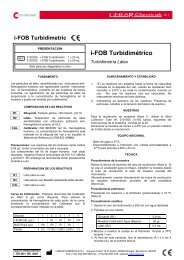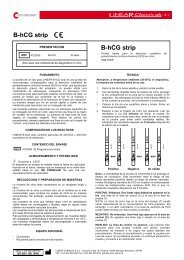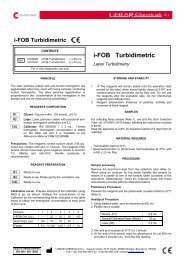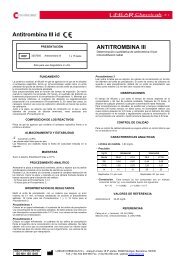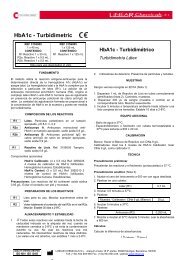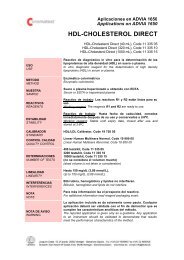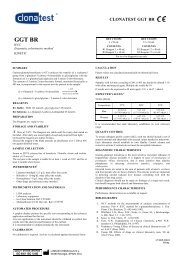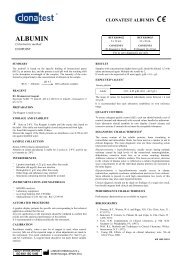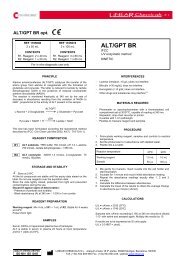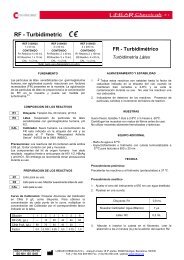Fecal occult blood cassette - Linear
Fecal occult blood cassette - Linear
Fecal occult blood cassette - Linear
You also want an ePaper? Increase the reach of your titles
YUMPU automatically turns print PDFs into web optimized ePapers that Google loves.
<strong>Fecal</strong> <strong>occult</strong> <strong>blood</strong> <strong>cassette</strong>REF4325225CONTENTS<strong>Fecal</strong>Occult Blood25 TestsFECAL OCCULT BLOODA rapid one test for the qualitative detection ofhuman <strong>occult</strong> <strong>blood</strong> in feces.ONE STEPFor professional in vitro diagnostic use onlyPRINCIPLEThe LINEAR <strong>Fecal</strong> Occult Blood is a qualitative, membrane basedsandwich immunoassay that has been designed for the detection ofhuman hemoglobin in stool specimen through visual interpretationof color development in the test device.In this assay fecal <strong>occult</strong> <strong>blood</strong> (FOB) is detected with the aid ofspecific antibodies against hemoglobin.After the addition of the sample (feces diluted in buffer) a colorlabelledantibody specifically binds to hemoglobin if it is present inthe sample. When this complex migrates upward on the membraneby capillary action, it is captured with the aid of another specificantibody at the test result line region of the test. A red test resultline is generated. If no hemoglobin is present the color labelledantibody cannot bind at the test result line region. No red test resultline is formed. So the presence of a colored test result lineindicates a positive result, while its absence indicates a negativeresult.To serve as a procedural control, a colored line will always appearin the control line region indicating that proper volume of specimenhas been added and membrane wicking has occurred.REAGENT COMPOSITIONFOB test device, contains anti-hemoglobin antibody particles andanti-hemoglobin antibody coated on the membrane.REF 4325225PACKAGING CONTENTS25 FOB test device25 Specimen collection tubes with extraction bufferWarning: The buffer contain sodium azide. Do not allow to contactwith skin or mucous membranes.STORAGE AND STABILITYPROCEDUREAllow test device, specimen collection tube, specimen, and/orcontrols to equilibrate to room temperature (15-30°C) prior totesting.1. To collect fecal specimens: Collect feces in a clean, dryspecimen collection container. Best results will be obtained ifthe assay is performed within 6 hours after collection.Specimen collected may be stored for 3 days at 2-8°C if nottested within 6 hours.2. To process fecal specimens:- Unscrew the cap of the specimen collection tube, thenrandomly stab the specimen collection stick into the fecalspecimen in at least 3 different sites. Do not scoop the fecalspecimen.- Screw on and tighten the cap onto the specimen collectiontube, then shake the specimen collection tube vigorously tomix the specimen and the extraction buffer. Specimenprepared in the specimen collection tube may be stored for6 months at -20°C if not tested within 1 hour afterpreparation.3. Remove the test device from the sealed pouch and use it assoon as possible.4. Hold the specimen collection tube upright and break off the tipof the specimen collection tube. Invert the specimen collectiontube and transfer 3 drops of the extracted specimen (approx.120 μL) to the specimen well (S) of the test device, and thenstart the timer. Avoid trapping air bubbles in the specimen well(S). See illustration below.5. Wait for the red line(s) to appear. Read results at 5 minutes.Do not interpret the result after 8 minutes.Store at 2-30ºC. The test device is stable through theexpiration date printed on the sealed pouch. The test device mustremain in the sealed pouch until use. DO NOT FREEZE. Do notuse beyond the expiration date.SPECIMEN COLLECTION AND PREPARATION• Specimen should not be collected during or within three daysof a menstrual period, or if the patient suffers from bleedinghemorrhoids or <strong>blood</strong> in the urine.• Alcohol, aspirin and other medications taken in excess maycause gastrointestinal irritation resulting in <strong>occult</strong> bleeding.Such substances should be discontinued at least 48 hoursprior to testing.• Dietary restrictions are not necessary.MATERIAL REQUIRED--Timer.Specimen collection container.QUALITY SYSTEM CERTIFIEDISO 9001 ISO 13485LINEAR CHEMICALS S.L. Joaquim Costa 18 2ª planta. 08390 Montgat, Barcelona, SPAINTelf. (+34) 934 694 990 Fax. (+34) 934 693 435. website www.linear.es
POSITIVE: Two distinct red lines appear. One line should be inthe control region (C) and another should be in the test region (T).NOTE: The intensity of color in the test line region (T) will varydepending on the concentration of <strong>Fecal</strong> Occult Blood present inthe specimen. Comparison of the line intensities is notrecommended.NEGATIVE: One red line appears in the control region (C). Noapparent colored line appears in the test region (T).INVALID: Control line fails to appear. Insufficient specimenvolume or incorrect procedural techniques are the most likelyreasons for control line failure. Review the procedure and repeatthe test with a new test device. If the problem persists, discontinueusing the test kit immediately and contact your local distributor.QUALITY CONTROLA procedural control is included in the test. A colored lineappearing in the control line region (C) is considered an internalprocedural control. It confirms sufficient specimen volume,adequate membrane wicking and correct procedural technique.Control standards are not supplied with this kit; however, it isrecommended that positive and negative controls be tested as goodlaboratory testing practice to confirm the test procedure and toverify proper test performance.Note: When testing control material dissolved in buffer thebackground of the assay is usually clear within 5 minutes. However,when fecal samples are tested, the background may appear slightlyyellowish due to the original color of the fecal samples. This isacceptable as long as it does not interfere with the interpretation oftest result. The test is invalid if the background fails to clear andobscures the reading of the result.CLINICAL SIGNIFICANCEMany diseases can cause hidden <strong>blood</strong> in the feces. This is alsoknown as <strong>Fecal</strong> Occult Blood, Human Occult Blood, or HumanHemoglobin. In the early stages, gastrointestinal problems such ascolon cancer, ulcers, polyps, colitis, diverticulitis, and fissures maynot show any visible symptoms, only <strong>occult</strong> <strong>blood</strong>. Traditionalguaiac-based methods lack sensitivity and specificity, and alsohave diet-restriction prior to the testing. The LINEAR <strong>Fecal</strong> OccultBlood is a rapid test to qualitatively detect low levels of <strong>Fecal</strong> OccultBlood. The test uses double antibody sandwich assay to selectivelydetect <strong>Fecal</strong> Occult Blood at 50 ng/mL or higher or 6 μg/g feces. Inaddition, unlike guaiac assays, the accuracy of the test is notaffected by the diet of the patients.ANALYTICAL PERFORMANCEA. Analytical SensitivityA sample containing human hemoglobin at concentration equal to 2µg Hemoglobin/g feces (resp. 40 ng Hemoglobin/mL buffer afterextraction) produces a positive result. In some cases samplecontaining human hemoglobin at concentrations less than 2 µg/gfeces can also be tested as positive.Hook or Prozone effectSample containing as high as 1,250 µg hemoglobin/g feces (0.5mg/mL buffer) can still test positive. The <strong>Linear</strong> FOB Tests do notshow a Hook or Prozone Effect up to the maximal observedphysiological concentration (500.000 ng/mL=0,5 mg/ml). Thus, theworking range is 40 ng/mL up to 500,000 ng/ml buffer resp. 2 µg upto 1,250 µg Hemoglobin/ g fecesB. Analytical Specificity<strong>Linear</strong> FOB Test is specific for human hemoglobin and does notshow any cross-reaction with the hemoglobin from bovine, pig,horse and sheep up to concentrations of 0.5 mg/mL.Hemoglobin from rabbit and polecat may cause cross reactions.<strong>Linear</strong> FOB Test does not show any cross reaction with billirubin,vitamin C and horse radish peroxidase.C. Clinical SpecificityThe following non-cancer related factors may cause <strong>blood</strong> in fecessamples:1. Iron. Food supplementation with iron leads to increased releaseof <strong>blood</strong> in the colon. Iron itself is not cross-reacting with the test.2. Acetylsalicylic acid. ASA is main compound in a lot of drugsagainst headache, and is sometimes used to substitutemacumar as a <strong>blood</strong> diluter. Almost always there are very smallamounts of <strong>blood</strong> in fecal samples in case of healthy humans.This is far below the sensitivty of our test and has nothing to dowith cancer or any other serious matter. However, if a patienttakes <strong>blood</strong> diluters bleeding can be more intensive. Thereforethe cut-off of <strong>Linear</strong> FOB test may be reached.3. Coumarin. Used as drugs (e.g. Macumar®) for prevention ofheart attacks, against thrombosis and stroke. Similar to ASA,cumarines are <strong>blood</strong> diluters. Almost always there are very smallamounts of <strong>blood</strong> in fecal samples in case of healthy humans.This is far below the sensitivity of <strong>Linear</strong> FOB test and hasnothing to do with cancer or any other serious matter. However,if a patient takes <strong>blood</strong> diluters, bleeding can be more intensive.Therefore the cut-off of LINEAR FOB test may be reached.4. Hemorrhoids. Therefore fecal sample may be contaminated with<strong>blood</strong> which is not associated with cancer.5. Monthly period. Small amouts of <strong>blood</strong> released because offemale´s period may contaminate the fecal sample. This is <strong>blood</strong>which is not associated with cancer.6. Urine samples. Several diseases may cause <strong>blood</strong> in urinesamples. To avoid detection of urine-related <strong>blood</strong>, stool sampleshould not get in contact with urine.PRECAUTIONS• Do not mix sample collection tubes from different lots.• Do not touch or spill liquid onto the white membrane in the testresult window.• Avoid cross-contamination of samples by using a new specimencollection container and new specimen collection tube.• All patient’s samples should be treated as if capable oftransmitting disease. Adequate handling and disposal methodsshould be established. It is recommended to wear protectiveclothing such as laboratory coats, disposable gloves and eyeprotection when specimens are being tested. Do not eat, drink orsmoke in the area where specimens or kits are handled.• Ensure that patients closely follow the specimen collectionprocedures.NOTES1. LINEAR <strong>Fecal</strong> Occult Blood will only indicate the presence of<strong>Fecal</strong> Occult Blood, the presence of <strong>blood</strong> in feces does notnecessarily indicate colorectal bleeding.2. As with all diagnostic tests, all results must be consideredwith other clinical information available to the physician.3. Other clinically available tests are required if questionableresults are obtained.REFERENCES1. Dam, J.V., et. al.; Feccal Blood Screening for Colorectal Cancer;Archive of Internal Medicine; (1995) 155:2389-2402.2. Frommer, D.J. et. al.; Improved Screening for Colorectal Cancer byImmunological Detection of Ocult Blood; British Medical Journal;(1988) 296:1092-1094.3. Lieberman, D.; Screening/Early Detection Model for ColorectalCancer, Why Screen? Cancer Supplement; (1994) 74(7):2023-2027.4. Miller, A.B.; An Epidemiological Perspective on Cancer Screening;Clinical Biochemistry (1995) 28(1): 41-48.5. Ransohoff, D.F. and Lang, C.A.; Improving the Feccal Occult-BloodTest; The New England Journal of Medicine; (1996) 334 (3):189-190.6. Screening for Colorectal Cancer-United States, 1992-1993, and NewGuidelines; Mobility and Mortality Weekly Report; (1995) 45 (5): 107-110.7. St. John, D.J.B., et al.; Evaluation of New Occult Blood Test forDetection of Colorectal Neoplasia; Gastroenterology; (1993)104:1661-1668.8. Yamamoto M., Nakama H., Cost-effectiveness analysis ofimmunochemical <strong>occult</strong> <strong>blood</strong> screening for colorectal cancer amongthree fecal sampling methods: Hepatogastroenterology, 2000 Mar-Apr, 47 (32) 396-399.O4325-3/0903R1.ingQUALITY SYSTEM CERTIFIEDISO 9001 ISO 13485LINEAR CHEMICALS S.L. Joaquim Costa 18 2ª planta. 08390 Montgat, Barcelona, SPAINTelf. (+34) 934 694 990 Fax. (+34) 934 693 435. website www.linear.es




